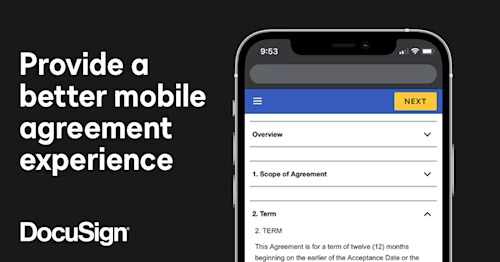
Reducing risk through electronic signing
This article goes into the topic of duress relating to electronic signatures.

This blog is co-authored by Doug Luftman, Vice President & Deputy General Counsel at Docusign, Helena Busljeta, Special Counsel at King & Wood Mallesons and Dale Rayner, Partner at King & Wood Mallesons.
As digital transformation in Australia accelerates, contracts that would traditionally be signed by parties on paper with wet ink are now being signed electronically and when necessary electronically witnessed and sometimes even in a remote manner (e.g., virtual witnessing). Over the years, there have been questions posed as to how effective is electronic signatures and remote witnessing in reducing the risk that a signatory who is signing a contract:
is being coerced into signing the contract through outside pressures (that is, subject to duress or undue influence); or
does not fully comprehend the content of the contract that they are signing.
This question is partly explained by an incorrect perception that people meeting face to face, including physically witnessing a signing ceremony, somehow have a greater ability to detect whether a signatory is entering into the contract freely and understands what he or she is signing. There is a specific presumption that somehow an individual in person can read the room better, that the credentials reviewed by the individual are reviewed more fully, and that people potentially hidden in other rooms can be sensed by that individual through the interaction. In fact, all of this is anecdotal and in fact is less effective due to the less documented evidence as to what was actually said or done during the signing ceremony, what acts were truly taken to review the credentials, and/or what other interactions may have or may not have occurred in the engagement prior to the reviewing of the document(s) and the signing ceremony having been completed.
In fact, electronic signing solutions, like Docusign eSignature, can reduce the risk of a person being pressured or threatened into entering a contract, as well as other contractual risks. In particular, platforms such as Docusign eSignature, can provide the ability to control exactly what a signatory sees in the document and capture more of a signer’s behaviour by tracking the electronic signing of a document. This digital-first approach promotes greater assurance as to the specific steps the signatory took in electronically signing and establishes a more robust digital audit trail of the activities taken. Further, in the instance of the added step of having a third party witness certain documents being signed, the effectiveness of greater assurance increases even further because the steps of the witness are no longer implied in the witness signing, but generally through electronically signing and specifically with regard to virtually signing, additional witnessing behavior can be documented and incorporated into the digital audit trail, such as what actions the witness actually took (e.g. confirming identity with a specific identity tool) as well as recording specific portions of the signing ceremony through such means as an audio visual recording. These benefits associated with an electronic signing ceremony help ensure that there is a greater evidentiary record that the person signing is not being coerced and comprehends the content of the contract he or she is signing.
A brief overview of the law
A Court may set aside a contract where a party did not make a free and deliberate decision to enter into the contract. This may have occurred because the party was subjected to pressure to sign the contract because of duress or undue influence or because the other party engaged in unconscionable conduct.
A contract is affected by duress where a person was coerced to enter into it by an illegitimate threat amounting to compulsion. The threat could be a threat of physical violence, a threat to damage goods owned by that person or a threat to the economic wellbeing of the person.
Undue influence also is concerned with pressure affecting the contractual assent of one of the parties. A contract is affected by undue influence if a party enters into the contract as a result of undue pressure by another person. The person exerting the undue influence may be the other party or a third person. Undue influence usually arises where there is an inequality of power between the contracting parties and the dominant party acts in such a way as to effectively deprive the other party of their free will. In some cases, the court will presume that there has been undue influence based on the relationship between the parties, such as where the relationship falls within a certain established class like parent and child or lawyer and client.
Unconscionable conduct occurs where one party takes unconscionable advantage of some special disability of the other party to enter into the contract (e.g., if a party enters into a contract written in English knowing the other party cannot read or speak English).
Reducing the risk with Docusign eSignature
There are many ways that using an electronic signing platform, like Docusign eSignature, can help you reduce the risk of duress, undue influence and unconscionable conduct.
With Docusign eSignature, you can:
Control the workflow
walk signatories through a contract. For example, notes can be added into a document which explain key areas / clauses, and specific digital workflow can be configured to ensure signers stop and review specific, required points in the document.
insert checks / requirements as part of the agreement signing workflow to minimise risk. For example, a party can require signers to acknowledge reading sections of a document as part of the workflow. Further, the workflow could even prevent completion of a document unless signers specifically acknowledge these checks.
request the signatory to expressly acknowledge that they have understood what they are signing. For example, a party can require a signer to answer questions, fill out specific information or perform other actions that signify that the signer understands one or more specific provisions in the document being signed.
require the signatory to initial each page, or specific, important sections.
Explain the contract by
highlighting key or important areas.
providing additional helpful information, like tips or explanations. For example, inbuilt comments is available for signers to have information specifically conveyed to them when reviewing the document.
allowing signatories to communicate with the sender of the document for questions or clarification. For example, chat functionality is available for signers to ask questions and get instant responses from senders or other recipients. In other jursidications, such as in the United States, shared audio / video session, which can be recorded, between parties is available so that a party can observe, comment and guide a signer as to what they need to do in reviewing and signing of a document.
Manage attachments or supplemental documents by
applying rules to the contract which indicate that specific pages have been Viewed, Understood, Acknowledged or Read
Ensure contracts are readable by
ensuring contracts are legible on a large or small screen, mobile device, tablet or PC using responsive design
Control the contract timeline by
placing expiry on contract timeline, which can reduce the ability for someone to be under duress by enabling that person to use inaction as a countervailing force to duress . For example, a time limit can be placed on the contract which means it must be completed / signed by a specific date. This limitation generally fixes the length of time someone has to sign a document and can limit the amount of coercion or duress that can be placed on a signer. A person unwilling to sign therefore merely would have to wait for the contract time to expire, rather than having to take an overt action, such as refusing to sign or directly confronting the coercive force.
Enable parties to reject signing the contract by
asking if the signatory is entering into the contract of their free will
giving the signatory the ability to decline to sign
giving the signatory the ability to assign to someone else to sign, and capture evidence of this process. For example, in circumstances where the initial signer is uncomfortable signing the document and may be feeling coerced, the signer can have an option of merely reassigning the document to a more appropriate person – this can remove the burden on the initial signer to sign and allow a more appropriate person to make the decision and/or engage in a conversation with the original signer.
Give signatories the ability to get independent advice or raise concerns in real time by
enabling comments – a live chat through the contract**.** For example, the comments / chat functionality can be sent to the sender, specific recipients or all recipients at once. This is decided by the sender of the comment.
giving the signatory the ability to speak with or send messages to the sender.
using workflow to capture any concerns before progressing to final signing. For example, document workflow does not have to be simply to request a signature on a document. The sender can build the workflow to route the document first to signers / parties for review and comment, before sending out a final agreed version for actual signing.
Ensure parties believe that the contract is fair
use workflow to pose questions such as “I believe this contract is fair”
provide voice or video recording capability so that the signers and/or witnesses can further document the understanding or intent of the contracting parties
Give signatories reasonable options for parties to modify the contract
use a multiple step process, which includes options allowing signatories to edit
See or hear signatories in real time during the review of the contract and/or signing ceremony
use video or voice recording of the signing process, for instance to detect intoxication
Record an audit trail of key actions and other identifying information whether merely digital or also via audio / visual recording technology
require proof of identity to ensure the right person is signing the contract
capture the key actions via video, record audio assent and/or specific critical actions during the contract review and signing process, notate IP address of devices used to sign and/or use location-based tracking (e.g., GPS) to see where parties are signing from and whether they are using the same device
Managing the many risks exist in the contracting process
Any contract process runs the risk of contracts being sent to incorrect recipients, contracts going missing or not being delivered, parties modifying the contract, back dating, parties only signing the front page, unauthorized parties having access to sensitive documents or portions of the documents and/or making copies of the documents, and confidential documents being sent to the wrong people. These risks can be mitigated via Docusign eSignature by using a robust workflow process that documents the contract review and signing process, controls access to the documents and also can provide a guided journey to further ensure that the parties understand and acknowledge that understanding to what they are contractually agreeing.
Many organisations recognise the risk posed by duress and are looking to build steps into their online and offline processes to highlight where duress may exist and to mitigate it where possible.
Electronic devices or mobile software application alarms can allow a person to silently raise a call to authorities when they feel threatened or under duress. Similar technology could be integrated with signing solutions to silently flag duress while an individual under duress is signing a contract. For instance, an organisation (such as a bank) could set up an icon or link on the signing screen that a person could click on if they felt under duress, undue influence or even if they do not understand what they are signing. This approach could have no visible indicator to other parties, who might be present while the signer is reviewing and being asked to sign a contract. Organisations could then include information about this process to highlight such duress mitigation procedures in their documentation.
Complementary approaches to further strengthen reducing risk
The risk of duress, undue influence and unconscionable conduct can be further reduced by:
providing for another person to remotely witness the document as an additional participant in the electronic signing process
using audio/visual technologies such as a commercial off the shelf product, like Zoom, to create a collaborative environment to engage with the signatories and witness, while they are signing, and record the signing and witnessing process
using integrated audio/visual collaborative technologies, such as Docusign Notary, in jurisdictions where such products/technologies are available, to create an enhanced digital experience where an audio/visual audit trail of the interaction between the signatories and the electronic witness becomes part of the auditable record of the transaction
Related posts
Discover what's new with Docusign IAM or start with eSignature for free


